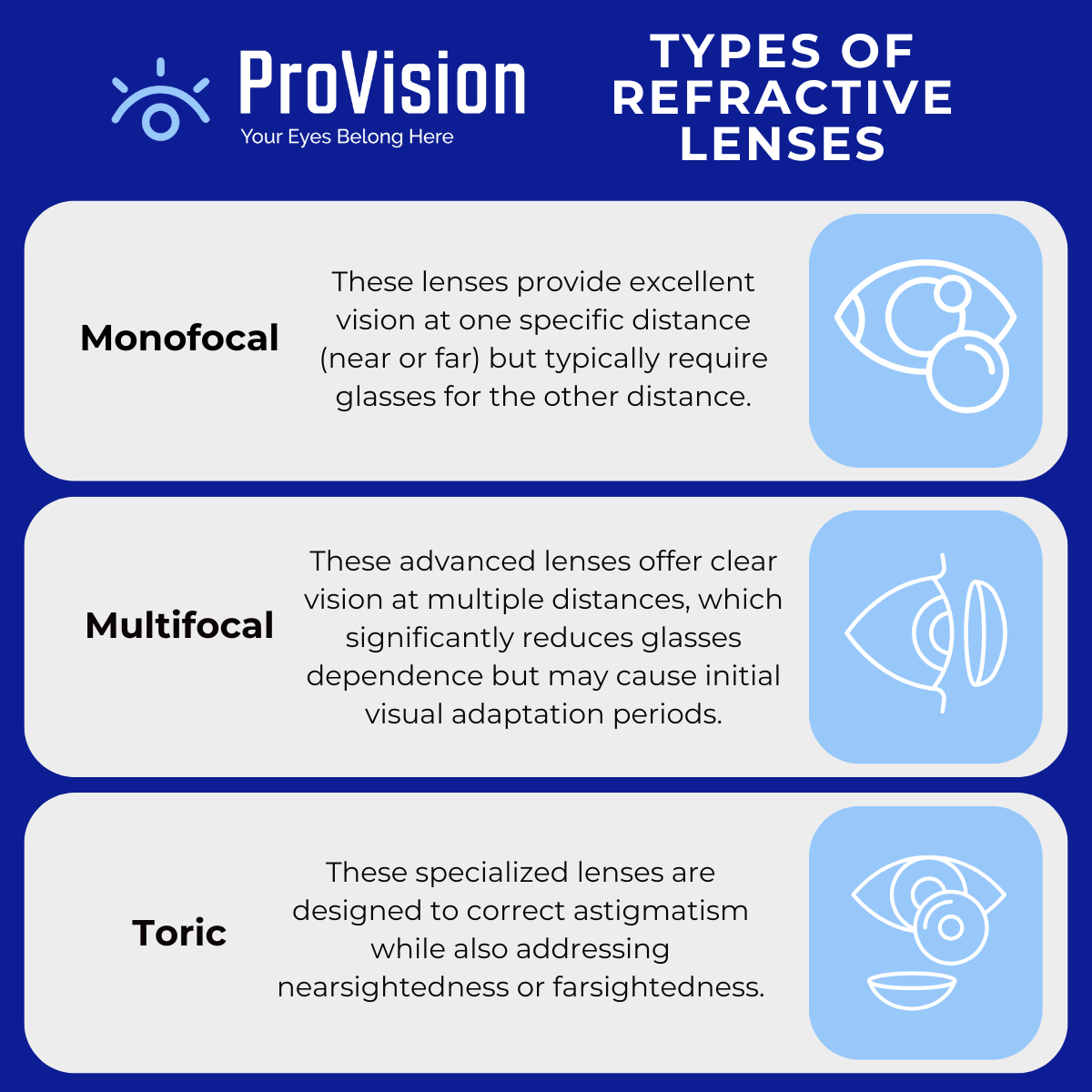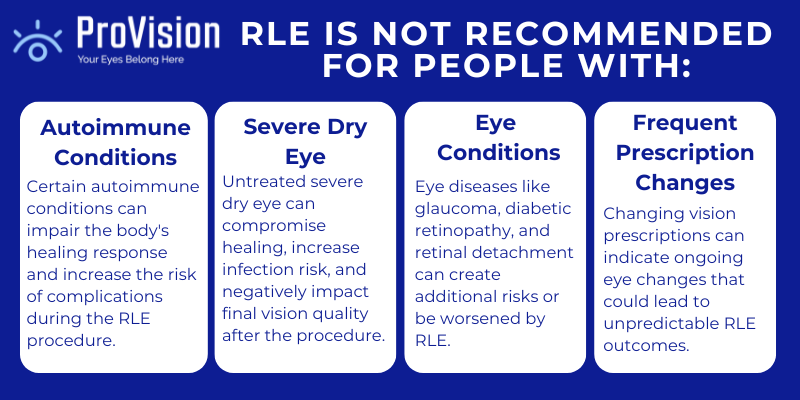What to Know About Refractive Lens Exchange
At a Glance: Refractive lens exchange is a vision correction surgery where your eye's natural lens is replaced with an artificial intraocular lens. It can correct various vision problems and prevent future cataracts.
Refractive lens exchange (RLE) is a surgical procedure that replaces your eye's natural lens with an advanced artificial one, offering clear vision at multiple distances. While similar to cataract surgery, RLE is performed before cataracts develop, making it an excellent option for people who want to reduce their dependence on glasses or contact lenses.
RLE can be particularly helpful for presbyopic patients over 40 who have difficulty focusing on close objects, high degrees of farsightedness, or those who aren't good candidates for LASIK surgery. Unlike laser vision correction procedures that modify the cornea, RLE changes the eye's natural lens, addressing vision problems at their source while preventing cataracts from developing later in life.
Understanding Refractive Lens Exchange
What is RLE?
RLE is an advanced vision correction procedure that involves surgically removing the eye's natural lens and replacing it with an artificial intraocular lens (IOL). These intraocular lenses correct refractive errors and reduce dependence on glasses or contact lenses. Unlike cataract surgery, which addresses clouded lenses, RLE is performed on clear, natural lenses to treat conditions such as severe nearsightedness, farsightedness, astigmatism, and presbyopia.
The procedure addresses vision problems at their source within the eye's optical system. During RLE, the surgeon makes a small incision in the cornea and uses ultrasonic energy to gently break up and remove the natural lens. The artificial lens is then carefully positioned in the same location as the original lens, restoring the eye's ability to focus light properly on the retina.
Refractive Lens Options
These specialized lenses feature different powers in different meridians of the lens to compensate for the irregular corneal shape that causes astigmatism, providing clearer, more focused vision.
Monofocal IOL Lenses
These provide clearer vision at one specific distance, typically optimized for either near or distance vision. Patients choosing monofocal lenses usually achieve excellent clarity for their chosen focal point but may still require reading glasses or distance glasses depending on their lens selection. These lenses offer reliable, consistent vision correction and are often the most cost-effective option.
Multifocal IOL Lenses
These feature multiple zones with different focusing powers, allowing patients to see clearly at various distances including near, intermediate, and far. These advanced lenses can significantly reduce dependence on glasses for most daily activities, though some patients may experience initial adaptation periods or minor visual phenomena such as halos around lights.
Toric Lenses
Specifically designed to correct astigmatism, these lenses also address nearsightedness or farsightedness.
Technology and Techniques
Modern RLE procedures utilize sophisticated surgical techniques, including femtosecond laser technology for precise incisions and advanced phacoemulsification systems that use ultrasonic energy to safely fragment and remove the natural lens. These technologies allow for smaller incisions, faster healing times, and more predictable outcomes.
Advanced lens materials include:
Hydrophobic & Hydrophilic Acrylics: These provide excellent optical clarity, biocompatibility, and long-term stability within the eye.
Blue Light Technology & Aspheric Designs: These reduce optical aberrations and improve contrast sensitivity, particularly in low-light conditions.
Computer-Guided Surgical Planning & Intraoperative Aberrometry: By further enhancing precision, these allow surgeons to make real-time adjustments during the procedure for optimal lens positioning and power selection.
Ideal Candidates for RLE
Who Should Consider RLE?
RLE works best for people aged 40 and older who want to reduce their dependence on glasses or contact lenses. This procedure is particularly helpful for individuals with farsightedness, age-related vision loss (presbyopia), very high prescriptions, or other refractive errors that may not be suitable for laser vision correction procedures like LASIK or PRK.
The procedure is well-suited for adults who:
Have poor visual acuity, including difficulty reading or seeing objects up close
Need different prescriptions for distance and near vision
Want to decrease their reliance on reading glasses or bifocals
Lead active lifestyles and find glasses inconvenient
Have stable vision prescriptions for at least one year
Medical Requirements
Before pursuing RLE, candidates must meet several health requirements:
- Good overall eye health with no serious conditions - No history of retinal detachment - Healthy corneas without significant scarring
Well-controlled dry eye, if present
No active eye infections or inflammation
Reasonable expectations about surgery outcomes
Your eye doctor will examine your eyes thoroughly to check the shape and health of your cornea, measure your prescription, and evaluate your retina and optic nerve.
When RLE is Not Recommended
RLE may not be appropriate for people who:
Have certain autoimmune disorders
Experience frequent changes in vision prescription
Have advanced glaucoma or diabetic retinopathy
Show signs of keratoconus or retinal detachment
Have severe dry eye that isn't responding to treatment
For these individuals, alternative vision correction options might include LASIK, PRK, contact lenses, or traditional glasses. Your eye doctor can help determine which solution best matches your specific situation.
The RLE Procedure and Recovery
Before Surgery
Prior to undergoing an RLE procedure, you'll have a detailed consultation where your eye doctor performs a complete eye examination. During this visit, they measure your eye's shape, size, and refractive error. Your doctor will also review your medical history and discuss your vision goals.
Preoperative testing includes:
Corneal Mapping
Measuring Eye Pressure
Determining the Power of the Artificial Lens Needed
Your doctor may perform additional tests to check your eye health and rule out any conditions that could affect surgery. To prepare for surgery, you'll need to:
Stop wearing contact lenses for several weeks before testing
Arrange transportation home after surgery
Follow instructions about eating and drinking before surgery
Begin using any prescribed eye drops
During Surgery
The RLE procedure typically takes about 15-20 minutes per eye. Your surgeon begins by applying numbing eye drops for comfort. You remain awake during surgery, but feel no pain. A small device holds your eye open while you relax and look at a light. The surgical steps include:
1. Creating a tiny incision in the cornea
2. Breaking up and removing your natural lens
3. Placing the new artificial lens in position
4. The incision typically self-seals without stitches
Recovery Timeline
Immediately after surgery, you'll rest in a recovery area for a short time. You might have blurry vision at first, and your eyes might feel slightly scratchy. You'll wear protective shields over your eyes, especially while sleeping.
Short-Term Recovery
First 24-48 hours: Rest your eyes and use prescribed drops
First week: Avoid strenuous activity and keep water out of your eyes
Vision begins improving within a few days
Follow-up visits check your healing progress
Long-term results develop over 3-6 weeks as your eyes adjust to the new lenses. Most people return to normal activity within a week. Your vision continues to stabilize, with final results appearing around one month after surgery. Regular check-ups monitor your eye health and vision quality in the following months.
Let ProVision Eye Associates Guide You Through Your Eye Health Options
A refractive lens exchange procedure offers a permanent solution for people seeking freedom from glasses and contact lenses. The procedure replaces your natural lens with an advanced artificial one, correcting vision problems while potentially preventing future issues such as cataracts.
When deciding if RLE is right for you, consider your age, lifestyle needs, and current vision problems. The best candidates are typically those over 40 with presbyopia, moderate to severe farsightedness, or early signs of cataracts. The procedure's long-term benefits often outweigh the initial investment for many patients.
At ProVision Eye Associates, we understand that any eye procedure is an important decision. Our experienced team provides detailed consultations to help you understand your options and determine if RLE matches your vision goals and can provide a recommendation for a procedure. Schedule an appointment with our optometrists to learn more about how RLE and other vision treatments can improve your quality of life.




